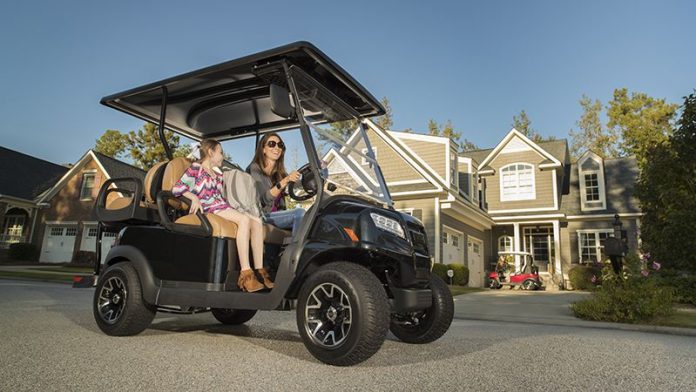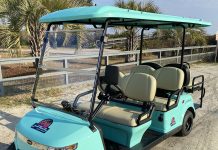
The history of Club Car, just as you would suspect, follows the history of the sport itself, owing its start to the rising popularity of the game in the 1950s.
In fact, we might credit Arnold Palmer – among other things, the inventor of a popular lemonade/ice tea summer drink – for bringing us the motorized golf cart in any shape or form, simply because it was the great golfer’s gift to legions of fans to introduce them to the game, thereby putting pressure on the sport to find an innovative gadget to help golfers tote their equipment around.
You need one bat in baseball and one racquet for tennis and you don’t have to travel that far to use them. But golf relies on a battery of woods and irons, plus tees, balls, towels, brushes, scorecards, pencils and a few miniature entrenching tools packed all into a heavy bag and hauled around a 6,000 yard course. So you can see where the problem lies.
We might look back on 1954 as a pivotal point in the progression that jumps from the once-familiar sight of seeing a group of human caddies lounging around the clubhouse to one in which the human carriers have become all but extinct, giving way to the motorized muscle that gets us through a round.
The Pressure is On…
Two major events occurred in 1954 that put pressure on the sport to find a motorized golf-bag carrier. This was the year Arnold Palmer turned pro. It was also the year in which the U.S. Open was broadcast nationally on television for the first time.
The ensuing jump in golf popularity set the stage for the motorized equipment that golfers around the world use to play the game. The Club Car company in particular started production in Houston, Texas in 1958 , incorporated as Landreath Machine. It was sold in 1962 to the enterprising Bill Stevens Jr., however, who moved the company to his hometown of Augusta, Ga., a location known to golfers around the world due to the Masters Tournament and the company’s rival E-Z-GO, which is also headquartered there.
The year 2018 marks the 60th year that Club Car has been producing some of the most reliable and recognizable machines ever made, given the relatively few changes that the cart has undergone over six decades.
The Club Car Design
Big auto companies upgrade car models almost on an annual basis, but this isn’t the case with the reliable, utilitarian Club Car, where sticking to a good things is the modus operandi and where the design over the years has been almost as consistent as the design of a wheelbarrow. There have been steady improvements in materials and the introduction of the gas engine power train in 1984, but the actual cart has been a model of efficiency that has required only two major overhauls since the 1960s to keep the company in business.
The most ground-breaking change was in 1975, when the company introduced the four-wheeled buggy configuration (that would be dune buggy, not insect-buggy). Prior to these workhorses, the company produced the three-wheeled models that did, in some ways, resemble a motorized wheelbarrow. It used three pedals – an accelerator, a brake and a parking brake – but it didn’t have a steering wheel. Instead, it had a long rudder-like handle for turning the singular front wheel. Like any leveraged mechanical device, the longer length of the handle made turning easier, but it also meant the end of the rudder could rotate considerably from left to right and back again.
The Carryall and the DS
The new buggy-style of Carryall has served the company well and may be the most ubiquitous carrier on golf courses around the country, aside from a kid in sneakers, that is.
One report notes that the original name for the 1962 to 1974 model was a bit of a disaster. The first cart was named “Caroche,” which was supposed to provide it with a sense of elegance. But that intention backfired, as golfers didn’t know how to pronounce the French word for carriage and many ended up saying something like “car roach,” which soon morphed into “cockroach.” As such, that name was quickly abandoned.
One time you can bet on a design change is when a company is sold and Stevens sold the company in 1973, which gave rise to the changes. In turn, the company was sold in 1978 to an investor group that included eight businessmen associated with rival E-Z-GO, which was also based in Augusta.
This investment group brought in a new designer named Dom Saporito, who helped develop a more stylish DS cart, that was launched in 1982 and utilized the designer’s initials for its name. This model featured the company’s first 48-volt electric motor, adding about 30 percent more power to the previous drive-train.
Sensing a potential for growth, the company also added a product line of landscaping workhorses known as turf or utility carriers. The Carryall line, as it is called, was launched in 1985, a year after it began offering a 4-cycle gasoline engine to power its golf carts.
From that point until 1993, few changes were made and only minor changes were made that year in terms of design. However, the company upgraded its body by switching to a new, nearly indestructible resin called “AmorFlex.”
Club Car makes some changes
The next radical change in the 1990s was under the hood. In 1992, the company switched to a 9 horse power 286cc Kawasaki engine, dropping the older 341 cc side valve engine. And in 1995 it came out with its first 48-volt electric engine option, an upgrade from the previous 36-volt option.
Other cosmetic changes came around with the company dropping the two-seat-back system to one continuous cushion in back – essentially moving to a park bench style for the back. The aluminum roof supports, meanwhile, were switched to black supports, each of these features, along with a move to triangular tubing for arm rests, coming around mid-way through 2000.
Related: Club Car Golf Cart Reviews
In addition, the roof itself was molded differently. This time, it had handles to hang onto and make it easier to climb in and out of the cart.
The company went public in 1993, and all of its outstanding stock was purchased by Clark Equipment Company in 1995, although that firm was bought out by Ingersoll Rand later in the year.
Sometime in the 1990s it also overtook E-Z-GO as the No. 1 seller of electric golf carts in the world.
In 2004, the company introduced a new model, the Precedent, trying out a more modern-looking sleeker golf cart that comes closer to resembling a sedan than a beach buggy. Of course, it is still a door-less, open cart for easy access, but one with an engine cowl out front and a below-the-body headlight placement. The headlines were now a continuous panel of lights loaded down low in front, as opposed to the recessed two-headlight system of spit headlines, like a most cars have.
The Precedent included a more rounded, look – less boxy – with better seats and an upgraded roof with a built-in drainage system. It’s battery compartment was new and made of one continuous mold, all but eliminating corrosion from spills.
The Precedent clips along at a perky 19 miles per hour, included to LED tail lights and a 360-degree, wrap-around bumper. The plastic was top-grade, durable and flexible, allowing it to withstand most moderate dings and clunks should they occur. The frame was also upgraded by switching to a trademarked material called AlumiCore that was both rust proof and non-corrosive.
Conclusion
It must be said that Club Car is a company that knows a good thing when they see it and the steady production without throwing too many changes at their ready public seems to have worked to their advantage. Back in 2001, the company rolled its one millionth vehicle off the assembly line – a testament to consistency and efficiency, while allowing the world’s golfers to take it from there.








Could you tell me who makes the engines for ClubCar???
Hi Bill, it depends on the make and model, however it has predominantly been Kawasaki
I have a 1991 model # AG9139263854, but it has the OHV engine. Is mine a transition model for 1992?
Hi, I do think this is a great site. I stumbledupon it 😉 I will return yet again since I saved as a favorite it.
Money and freedom is the greatest way to change, may
you be rich and continue to help other people.
Look at my web site monstertruck
What’s up everyone, it’s my first visit at this web site, and piece
of writing is genuinely fruitful designed for me, keep up posting such posts.
my web blog magic 8 ball